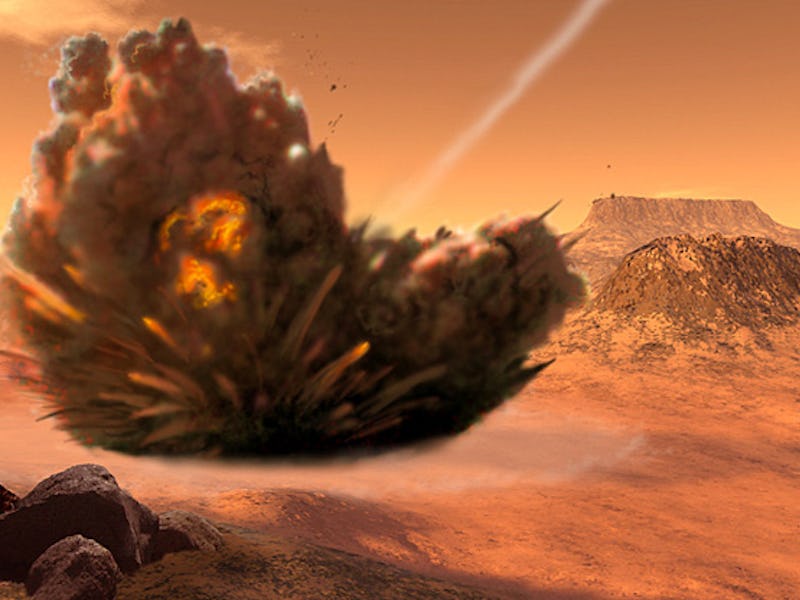Mars Attacked! Photo of Asteroid Collision Shows Its Amazing Impact Crater
We're just kidding, but a meteorite approximately five feet wide left a crater over 50 feet wide

A newly released image from NASA’s Mars Reconnaissance Orbiter (MRO) shows the incredible aftermath of an asteroid impact on the Martian surface.
Using its High Resolution Imaging Science Experiment (HiRISE), the MRO photographed the new crater on April 17, 2019, while orbiting at an altitude of 255 kilometers (158 miles), according to a HiRISE statement.
The crater is about 15 to 16 meters (49 to 53 feet) wide. The dark splotch created by the impact is around 500 meters (1,640 feet) wide, and the size of the meteorite is estimated at around 1.5 meters (5 feet) wide.
Here, on Earth, we’re well aware of the significance of potential asteroid strikes, but thankfully this chunk of space rock would more than likely not have survived the journey through Earth’s atmosphere since it’s considerably thicker than that on Mars.
The exact nature of the geography in this region is still uncertain, but just below the surface is probably basalt, and the blue could even be some ice that was just under the surface.
Dr. Bruce Betts, chief scientist at The Planetary Society, puts it into perspective for Inverse:
“When this size object hits Earth’s atmosphere, it breaks up, and at least most of it burns up before hitting the ground. Mars has a much thinner atmosphere, so these sized objects make it through to impact the surface. Though this sized asteroid would not make it through Earth’s atmosphere, seeing impacts like these is a reminder that we need to work on defending Earth from the impact of the larger asteroids that are out there.”
When an asteroid hits the surface of Mars, it throws material out from below the surface. Because much of Mars is covered by bright red dust and rusted rocks, the material thrown out is often darker than the surface material, as we see in this picture. The enhanced color accentuates bluer material, and that could represent material of a different composition than the surface rocks.
The asteroid impact took place in the Valles Marineris region, which sits near the Martian equator.
While the precise timing of the strike is unknown, astronomers think it was probably made sometime between September 2016 and February 2019.
The bluish areas in the false-color image above show areas in which the red surface material was most disrupted by the impact. The image was produced by Mars scientist and targeting specialist Veronica Bray from the University of Arizona, which operates the HiRISE.
“Most of the impacts we see are clusters of smaller craters, formed when the meteor breaks up in the Mars atmosphere. We’ve seen larger recent craters, say 20 and 30m across, but this is particularly striking because of its large dark and multicolored blast zone,” Bray told Inverse.
“Sometimes when we see blue in a HiRISE image, it can indicate water ice, but sometimes it just points us to compositional differences in rock and dust! So the area where the red dust has been removed by the impact appears blue to us in an enhanced-color HiRISE image.”
There’s a series of examples and further explanation on how this enhancing coloring works at the University of Arizona HiRISE website.
Enhanced-color products are created to emphasize material differences on the surface.